
Treating Sprains and luxations Page Menu: 1 2 3 4 5 6 7 8 9 10 11 12 13 Next>>
Treating Sprains & Dislocations in the Golden Age of Piracy, Page 2
Dislocations/Luxations
"...the midshipman had received no other damage than as pretty a luxation of the os humeri, as one would
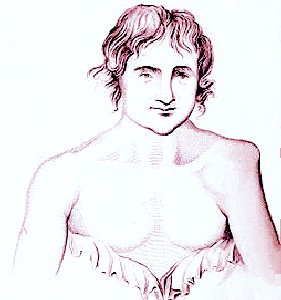
Humerus Dislocation, From A treatise on dislocations
and on fractures of the joints (1824)
desire to see on a summer's day. Upon this information, I crawled down to the cockpit, and acquainted Thomson [a surgeon's mate] with the affair, who, providing himself with bandages, &c., necessary for the occasion, went up to assist Mr. Morgan [the surgeon] in the reduction of the dislocation." (Tobias Smollett, The Adventures of Roderick Random, 1748, p. 177)
Nearly all surgeons from this period discuss dislocations in their book, firmly establishing healing them as part of the surgeon's work. Dislocations are sometimes referred to (both then and now) as luxations, often within the same text, as Smollett's quote above shows. (Luxation comes from the Latin word 'luxare' which here means dislocate.) French surgeon Ambroise Paré gives one of the more eloquent definitions of this term: "A Dislocation is a departure or falling out of the head of a bone from its proper cavity, into an accustomed place besides nature, hindring voluntary motion."1 English military surgeon Richard Wiseman simply defines it as "When ...two Bones, which being naturally united make up a Joint, are separated from each other"2.
Paré is quick to note that this is not the only type of dislocation. He defines three other types, although even he admits only two of them are of interest. The first of these two dislocations of interest occurs when the parts on either side of a joint are violently pulled away from each other which can happen to "those who have been tormented and racked... [or] who have suffered the Strappado"3.
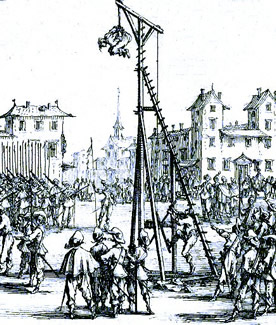
The Strappado, From The miseries of war, By
Jacques Callot (1633)
A person is strappadoed by having their hands tied behind their back and being suspended by a rope attached to their wrists. Paré notes that the rack can dislocate the thighs while strappado can dislocate shoulders. The second type of dislocation occurs when "bones which are joined contiguous, and one (as it were) bound to the sides of another, gape or fly asunder"4. This refers specifically to the two bones in the forearm (the ulna and radius) and the two in the lower leg (the tibia and fibula). Note that both of these types of luxation fit nicely in his basic definition - bones which have fallen out of their accustomed place.
Rather than divide them into separate types, Richard Wiseman discusses differences in the type of luxation. One of these differences is 'the degree' of luxation. He explains that a bone can "slip out wholly, or only in part, viz. to the margin of the Cavity that containeth it"5. Partial luxations "are the effect of an Humour soaking upon a Ligament, (as that of the Coxa [hip bone],) thereby making it liable to be stretcht, and to be thrust quite out upon every little force."6 Paré also talks about the degree of luxation, explaining that "[s]ome Dislocations are complete and perfect, as when the bone wholly fals out of its cavity; othersome are unperfect as when it is only lightly moved, & not wholly fallen out; wherefore we only cal them subluxations or strains"7. The term subluxation is still in use today; chiropractors adjust the spine to correct subluxations of the vertebrae.
Both authors also discuss the fact that bones can be luxated in different directions: forward, backward and to the left or right. When explaining how to correct some dislocated joints, Paré actually offers different procedures to restore the same joint luxations depending on which direction the bone has moved out of its socket.
1 Ambroise Paré, The Workes of that Famous Chirurgion Ambrose Parey, 1649, p. 379; 2 Richard Wiseman, Severall Chirurgicall Treatises, 2nd ed., 1686, p. 480; 3,4 Paré, p. 379; 5.6 Wiseman, p. 480; 7 Paré, p. 380
Causes of Dislocations/Luxations
Several authors list possible causes of dislocated bones. They begin with general causes and proceed to more specific ones. Ambroise Paré suggests three general causes: "Internall, externall, and hereditarie."1 Richard Wiseman and sea surgeon John Atkins leave hereditary causes out, focusing only on internal and external general causes. We will do likewise since luxation by hereditary causes would not typically be a problem found on a ship.
Internally caused dislocations refer to the humor-based theory popular during most of medical history. Humors are fluids in the body and their movement, flow and corruption were believed to be a part of nearly every medical problem that occurred. Wiseman suggests internal luxations are caused by "the
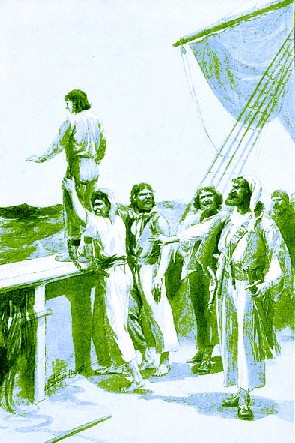
Man in Bilboes on Rail, From On fighting decks in 1812 (1899)
Humours which affect the Joints, and ...by relaxing the Ligaments give way to the Bone to depart from its natural seat; or by a contraction of the Tendons [which] put it upwards out of the Cavity."2
Paré gives a similar explanation, although his is somewhat more satisfying because it explains what the period surgeons thought the humors were doing. He suggests that "excrementitious [foul] humors and flatulencies [gases], which, settling into the joints with great force and plentie, do so make slippery, soften & relax the ligaments which bind together the bones, that they easily fal out of their cavities"3. Paré goes on to explain that humors can "so fil and distend these ligaments, and make them so short, that being contracted, they ...pluck them [away] from the bone whereon they are placed, or else draw ...the bones out of their cavities"4.
Sea surgeon Atkins greatly simplifies internal causes, stating that although they are uncommon and only occur "when a Heap of Humours is thrown on the Joint, relaxing the Ligaments."5 He notes that he has seen the heel of the foot luxated that way, but he doesn't spend much time discussing these types of dislocations in his book.
Given that humor theory has gone by the wayside, the external causes of dislocations sound much more satisfying today. Paré mentions several, reiterating torture as a cause and adding "fals from high [places], bruising and heavie blowes"6. Wiseman similarly mentions blows and falls and adds "violent Extension"7 or pulling apart. Atkins expands on this noting that luxation can be caused by "violent Extensions by sudden Slips in the inferior Limbs"8. Modern navy medicine author John Keevil points to some additional ship-specific causes including "punishments at the capstan or at the bilboes [shackles on the legs]"9.
1 Ambroise Paré, The Workes of that Famous Chirurgion Ambrose Parey, 1649, p. 380; 2 Richard Wiseman, Severall Chirurgicall Treatises, 2nd ed., 1686, p. 480; 3,4 Paré, p. 380; 5 John Atkins, The Navy Surgeon, 1742, p. 95; 6 Paré, p. 380; 7 Wiseman, p. 480; 8 Atkins, p. 95; 9 John J. Keevil, Medicine and the Navy 1200-1900: Volume I – 1200-1694, 1958, p. 226
Signs of Dislocations/Luxations
Sea surgeon John Atkins lists several general signs that a joint is luxated including "very imperfect Motion of the Joint; a Cavity whence the Head of the Bone is receded, and consequently a Proturbance where it is lodged. The Limb will appear shorter, or longer, and the Pain attending it,
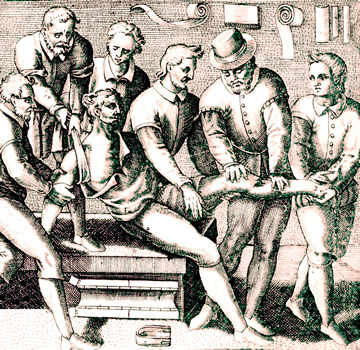
Frontispiece, La chirurgie francois, By Jacques Guillemeau (1594)
more, or less, according to what Bone is dislocated"1. If the dislocation occurred several hours ago he says there will be numbness and if it is long-standing, the muscles will be atrophied around it.
These signs are mentioned in both Richard Wiseman's and Ambroise Paré's book. Paré gives a fuller explanation of how the distorted length of the limb is to be recognized. This is performed by "comparing of the sound joint with that which is hurt, in which collation [comparison], it is fit the sound part, which is compared with the hurt be no waies, neither by nature nor any accident, wronged, nor deformed, nor withered or decayed, nor swol[le]n above measure, otherwise it may cozen [trick] and deceive you, if you be less warie."2
He also provides some observations on the signs of a partial luxation, something not addressed by the other authors. "Labour and difficulty of action in moving, is a sign of an uncomplete Luxation, or strain."3 Here, he says the connective ligaments have been "extended and relaxed, if the head of the bone, pressed with your fingers, be easily driven unto the contrary part, and suddenly fly thence back again; if thrusting your finger into the joint, it easily enter, nothing resisting it, as though all were empty within; if the motion be difficult, or none at all."4
1 John Atkins, The Navy Surgeon, 1742, p. 95; 2 Ambroise Paré, The Workes of that Famous Chirurgion Ambrose Parey, 1649, p. 380-1; 3,4 Paré, p. 381
Factors Affecting Dislocation/Luxation
The age and weight of a patient were two factors considered by some of the period surgeons to be relevant to the cause of dislocations and the amount of time they would take to heal.
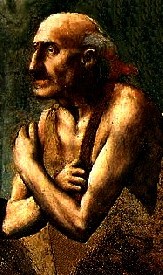
Artist: W.D. Cappella Brancacc (1427)
Ambroise Paré's comments, "Bones doe not easily fall out of joint in fleshy bodies; but when they chance to be put out, they are not easily got in again."1 He felt this was because the bones in larger people were tightly held in place by the muscles surrounding them. He contrasted this with people who "are leane, especially those who formerly have been more fat, have their joints more lax, whereby it comes to passe, that their bones may easily be put forth of joint"2. Paré explained that such people joints were filled "with mucous humors; whence it is, that the heads of the bones, as standing in a slippery place, are the lesse stable, as it is recorded by Hippocrates."3
Sea surgeon John Atkins advised that it was easier to put dislocated bones back in place for women and children than it was for men because of their "tender and lax Constitutions"4. He noted that was also easier to work on younger than older men since "in Age there is a natural Aridity [dryness] and Stiffness of the Joints, [which can be] increased by Delay in Reduction [restoring the bone], which necessitates a more than ordinary Extension [pulling the bone from its incorrect position], and that distracts the Fibrils, [stretches the fibers] constituting the Nerves and Tendons"5.
1,2,3 Ambroise Paré, The Workes of that Famous Chirurgion Ambrose Parey, 1649, p. 178; 4,5 John Atkins, The Navy Surgeon, 1742, p. 95
Preparation for Restoring Old and Humor-Caused Dislocations/Luxations
Before proceeding to the explanation of the mechanical repair of luxations, it is worth briefly exploring the method used to repair dislocations which period surgeons felt were internally caused (aka. created by an excess of humors). This was also felt to be the case for old dislocations where unwanted humors had been allowed to settle in the dislocated joint, making it tougher to extend and repair. Before these joints could be successfully restored, the unwanted humors had to be purged and prevented from interfering with healing. Surgeons during this period accomplished this with medicines.
Military surgeon Richard Wiseman recommends using emollient medicines, which will "resolve [dissolve] and breath forth the crude Humour affecting the Joint, Ligament and Tendons"1. He gives a recipe for a complex medicine he uses:
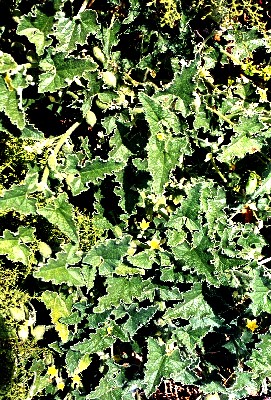
Photo: Omar Hoftun
Squirting Cucumber Plant (Ecballium elaterium)
Rx rad. althææ [marsh mallow root] {6 ounces} rad. cucumeris asinini [root of squirting cucumber - Ecballium elaterium] {3 ounces} summitat. majoran. [the tops of marjoram flowers] {2 Minums} coctis in brodio ex pedibus vitul. [cooked in calves foot broth] & contusis adde [beat and add] pulv. sem. fænugraci [powdered fenugreek seeds] & lini [powdered flax seeds] {of each 1 ounce} ol. lilior. [oil of lillies] axung. human. [human fat] an. part. æq. [of equal quantities] fiat Cataplasma [make into a cataplasm].2
As fascinating as this medicine sounds, many of the ingredients used were not usually found on ships during this period. Fortunately he also suggests some other plasters that were a part of the ship's medicine chest including: emplastrum diachylon cum gummi and emplastrum de ranis (plaster of frogs) with mercury.3
Sea surgeon James Handley recommended medicines for old dislocations in which the surgeon had to "[e]ndeavour to soften and discuss the matter which is flowed into the joynt, with Diach[ylon]. cum gummi, or a Medicine prepared Ex [using] Rad. Altheæ. [marsh mallow root] fol. malv. [mallow leaves] far. lini [flax meal], fænugræc. [fenugreek] ol. oliv. [olive oil] anxung. pocin. [pork lard] &c."4 Notice the overlap between Handley's remedies and Wiseman's. Handley goes on to recommend that the part to be extended be 'well rubbed' (or massaged) and placed in a warm bath for a long period.
Ambroise Paré also addresses the treatment of dislocations caused by humors, although he is less specific about the medicines that should be used in such cases. He tells the surgeon he "must endeavour to humect [moisten] the ligaments, tendons and muscles by fomentations, cataplasms, emplasters, liniments, and other remedies, that so these parts may be more obedient to the Surgeons hand"5. All of the medicines he recommends are topical. When applying such things, Paré advises the surgeon to use "a gentle motion up and down, to and again, that by this means the excrementitious humor, which by continuance of time hath flowed down, may wax hot, be attenuated, resolved or made slippery".6
1,2 Richard Wiseman, Severall Chirurgicall Treatises, 2nd ed., 1686, p. 481; 3 Wiseman, p. 482; 4 James Handley, Colloquia Chyrurgica, 1705, p. 155; 5,6 Ambroise Paré, The Workes of that Famous Chirurgion Ambrose Parey, 1649, p. 379

